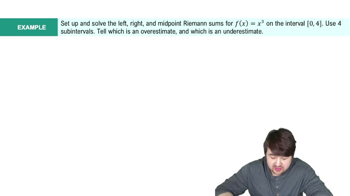Approximate the area under the curve over the interval using the Right Riemann sum with 8 subintervals.
Table of contents
- 0. Functions7h 54m
- Introduction to Functions16m
- Piecewise Functions10m
- Properties of Functions9m
- Common Functions1h 8m
- Transformations5m
- Combining Functions27m
- Exponent rules32m
- Exponential Functions28m
- Logarithmic Functions24m
- Properties of Logarithms36m
- Exponential & Logarithmic Equations35m
- Introduction to Trigonometric Functions38m
- Graphs of Trigonometric Functions44m
- Trigonometric Identities47m
- Inverse Trigonometric Functions48m
- 1. Limits and Continuity2h 2m
- 2. Intro to Derivatives1h 33m
- 3. Techniques of Differentiation3h 18m
- 4. Applications of Derivatives2h 38m
- 5. Graphical Applications of Derivatives6h 2m
- 6. Derivatives of Inverse, Exponential, & Logarithmic Functions2h 37m
- 7. Antiderivatives & Indefinite Integrals1h 26m
- 8. Definite Integrals4h 44m
- 9. Graphical Applications of Integrals2h 27m
- 10. Physics Applications of Integrals 3h 16m
- 11. Integrals of Inverse, Exponential, & Logarithmic Functions2h 34m
- 12. Techniques of Integration7h 41m
- 13. Intro to Differential Equations2h 55m
- 14. Sequences & Series5h 36m
- 15. Power Series2h 19m
- 16. Parametric Equations & Polar Coordinates7h 58m
8. Definite Integrals
Riemann Sums
Problem 5.2.31d
Textbook Question
{Use of Tech} Approximating definite integrals Complete the following steps for the given integral and the given value of n.
(d) Determine which Riemann sum (left or right) underestimates the value of the definite integral and which overestimates the value of the definite integral.
∫₃⁶ (1―2𝓍) d𝓍 ; n = 6
 Verified step by step guidance
Verified step by step guidance1
Step 1: Understand the problem. The integral ∫₃⁶ (1 - 2𝓍) d𝓍 represents the area under the curve of the function f(𝓍) = 1 - 2𝓍 from x = 3 to x = 6. We are tasked with determining which Riemann sum (left or right) underestimates or overestimates the value of the definite integral, given n = 6 subintervals.
Step 2: Divide the interval [3, 6] into n = 6 subintervals. The width of each subinterval, Δ𝓍, is calculated as Δ𝓍 = (b - a) / n, where a = 3 and b = 6. Substitute the values to find Δ𝓍.
Step 3: For the left Riemann sum, use the left endpoints of each subinterval to approximate the integral. The formula for the left Riemann sum is: Sₗ = Σ [f(𝓍ᵢ) * Δ𝓍], where 𝓍ᵢ represents the left endpoint of each subinterval. Compute the left endpoints and set up the summation.
Step 4: For the right Riemann sum, use the right endpoints of each subinterval to approximate the integral. The formula for the right Riemann sum is: Sᵣ = Σ [f(𝓍ᵢ) * Δ𝓍], where 𝓍ᵢ represents the right endpoint of each subinterval. Compute the right endpoints and set up the summation.
Step 5: Analyze the behavior of the function f(𝓍) = 1 - 2𝓍. Since f(𝓍) is a decreasing linear function, the left Riemann sum will underestimate the integral (as it uses lower values of f(𝓍)), while the right Riemann sum will overestimate the integral (as it uses higher values of f(𝓍)).
 Verified video answer for a similar problem:
Verified video answer for a similar problem:This video solution was recommended by our tutors as helpful for the problem above
Video duration:
2mPlay a video:
Was this helpful?
Key Concepts
Here are the essential concepts you must grasp in order to answer the question correctly.
Definite Integral
A definite integral represents the signed area under a curve defined by a function over a specific interval. It is calculated using the Fundamental Theorem of Calculus, which connects differentiation and integration. The notation ∫ₐᵇ f(x) dx indicates the integral of f(x) from a to b, providing a numerical value that reflects the net area between the curve and the x-axis.
Recommended video:

Definition of the Definite Integral
Riemann Sum
A Riemann sum is a method for approximating the value of a definite integral by dividing the area under the curve into smaller rectangles. The sum can be calculated using left endpoints, right endpoints, or midpoints of the subintervals. The choice of endpoints affects whether the sum underestimates or overestimates the integral, depending on the function's behavior over the interval.
Recommended video:

Introduction to Riemann Sums
Underestimation and Overestimation
In the context of Riemann sums, underestimation occurs when the chosen rectangles fall below the curve, while overestimation happens when they extend above it. For a decreasing function, the left Riemann sum will typically overestimate the integral, and the right sum will underestimate it. Conversely, for an increasing function, the left sum will underestimate, and the right sum will overestimate the integral.
Recommended video:

Left, Right, & Midpoint Riemann Sums Example 1
Related Videos
Related Practice
Multiple Choice
107
views
2
rank


